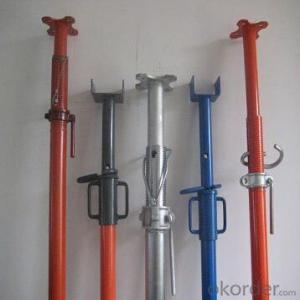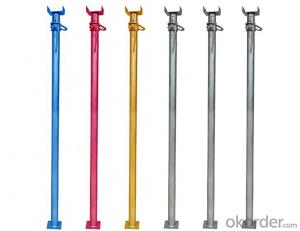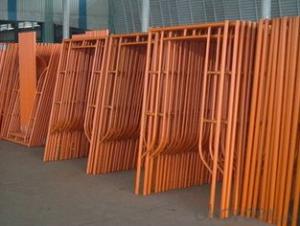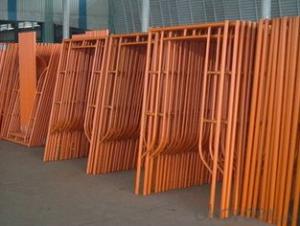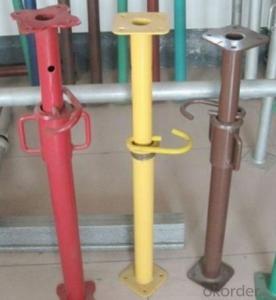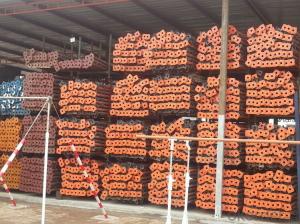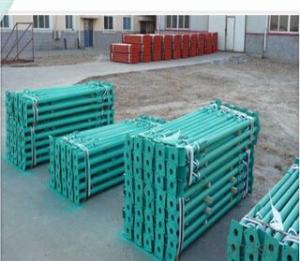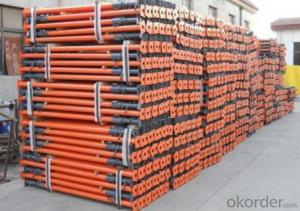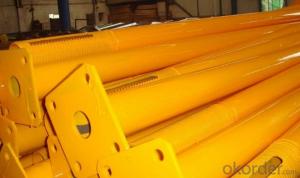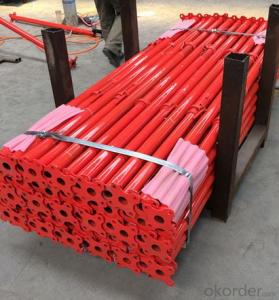heavy duty steel prop for scaffolding
- Loading Port:
- China Main Port
- Payment Terms:
- TT OR LC
- Min Order Qty:
- -
- Supply Capability:
- -
OKorder Service Pledge
OKorder Financial Service
You Might Also Like
| Brand Name: | Model Number: | ||||
| name: | surface: | package: | |||
| port:: | color: | Scaffolding Part Type: | |||
| material: | Certification: |
Packaging & Delivery
| Packaging Detail: | suitable for sea transportation |
| Delivery Detail: | Prompt |
Specifications
1.adjustable scaffolding steel prop
2.Model Size: Different size
3.Surface: Painted ,galvanized
4.Same price,better quality
adjustable scaffolding Steel prop
Scaffolding Adjustable Steel Props
Nut: Normal / Cup,
Size: Tailor mading,
Manufacturer with best price, quality & service!
2.2-3.9M Scaffolding Adjustable Steel Props
we are MANUFACTURER, can produce any size according to your demand.
this is some normal used catalog for props:
1. adjustable length: 0.8-1.4m / 1.6-3.0m / 2.0-3.6m / 2.0-3.5m / 2.2-4.0 m / 3.0-5.5 m
2. inner tube's diameter: 40 mm / 48 mm / 60 mm
3. outer tube's diameter: 48 mm / 56 mm / 76 mm
4. wall thickness: 1.6-4.0 mm
5. surface treatment: painted, e-galvanized, powder coated, hot dip galvanized
any detailed information or any questions, please contact me .
- Q: Are steel props adjustable for supporting structures with irregular shapes?
- Yes, steel props are adjustable and can be used to support structures with irregular shapes. The adjustable nature of steel props allows for customization and flexibility, making them suitable for various shapes and sizes of structures.
- Q: How are steel props assembled and disassembled?
- Steel props, also known as adjustable steel props or steel shore props, are typically used in construction to support temporary structures or provide scaffolding. Assembling and disassembling steel props involves a straightforward process. To assemble, the lower and upper sections of the prop are connected by sliding the inner tube into the outer tube until the required height is achieved. The prop is then secured by tightening the prop nuts or pins in place. Disassembling is simply the reverse process, where the nuts or pins are loosened, and the inner tube is slid out of the outer tube. This allows for easy height adjustment and removal of the prop. Overall, the assembly and disassembly of steel props are quick and efficient, making them a reliable choice in construction projects.
- Q: Are there any regulations or standards for using steel props?
- Regulations and standards exist for the use of steel props in the construction and engineering industries. Steel props, also called adjustable steel props or scaffolding props, are temporary support structures utilized for vertical support during construction or renovation activities. Various countries have building codes and safety standards that govern the use of steel props. These regulations guarantee that steel props are designed, manufactured, and utilized in a safe and efficient manner. While the specific regulations and standards may differ across jurisdictions, they generally encompass different aspects of steel prop usage, such as design criteria, load capacities, installation methods, and inspection requirements. An example of such regulations is the British Standard BS 4074, which specifies the criteria for adjustable steel props used in construction. It outlines manufacturing requirements, load capacities, safety factors, as well as guidelines for proper installation, bracing, and inspection procedures. Similarly, in the United States, the Occupational Safety and Health Administration (OSHA) sets standards for construction activities, including the use of steel props. OSHA regulations, like 29 CFR 1926 Subpart L, provide guidelines on scaffold use, including appropriate design, erection, and dismantling procedures for scaffolding systems, which may incorporate steel props. These regulations and standards are in place to ensure the safety of workers and the general public during construction activities. Their aim is to prevent accidents, collapses, and injuries resulting from faulty or improper use of steel props. Compliance with these regulations is typically mandatory and enforced by regulatory authorities, who may conduct inspections and issue penalties for non-compliance. Therefore, it is crucial for construction companies, contractors, and individuals involved in construction projects to be aware of and adhere to the applicable regulations and standards in their jurisdiction. They should ensure that the steel props used on their sites meet the necessary requirements, are correctly installed, and undergo regular inspections to ensure their integrity and safety.
- Q: Can steel props be used for supporting temporary mining structures?
- Supporting temporary mining structures can be achieved using steel props. These props are widely utilized in the construction industry to provide temporary support during construction or renovation projects. Designed to handle heavy loads and ensure stability, steel props are ideal for supporting temporary mining structures like tunnels, mine shafts, and underground chambers. Steel props possess adjustable features, making it easy to extend or contract them to fit the required height or length. This adaptability allows for their usage in various mining applications where different support requirements exist. Moreover, steel props are highly durable and resistant to corrosion, a crucial quality for mining environments that often involve exposure to moisture, chemicals, and other harsh conditions. Furthermore, steel props can be combined with other support systems such as timber or concrete, which enhances their load-bearing capacity and overall stability. This flexibility allows for the customization of support systems based on the specific needs of each mining project. Nevertheless, it is crucial to emphasize that the selection of support systems for temporary mining structures should be based on a comprehensive engineering assessment and compliance with relevant safety regulations. Seeking professional expertise and consultation is essential to ensure the appropriate design, installation, and maintenance of steel props or any other support systems utilized in mining operations.
- Q: What are the common maintenance and inspection requirements for steel props?
- To ensure the safe and efficient use of steel props, it is important to regularly check and repair them. The following are key maintenance and inspection tasks for steel props: 1. Clean the steel props regularly to remove dirt, debris, and other materials that may affect their performance. You can use a soft brush or cloth and mild detergent if needed. 2. Before and after each use, visually inspect the props to identify any signs of damage or wear. Look for cracks, dents, bends, or any structural issues that may compromise their integrity. 3. Check the load capacity markings to verify if the props are suitable for the intended load. Ensure that they are not overloaded, as this can cause failure or collapse. 4. If the props are adjustable, inspect the mechanisms used for height adjustment. Make sure they function properly, lock securely, and operate smoothly. Lubricate moving parts as necessary. 5. Examine the prop heads, which come into direct contact with the supported structure. Look for signs of wear or damage, such as excessive rust, missing or damaged pins, or loose parts. Promptly replace or repair damaged components. 6. Steel props are prone to corrosion, especially in moist or harsh environments. Follow the manufacturer's recommendations and apply anti-corrosion coatings or paints to protect the props and extend their lifespan. 7. Store the steel props in a clean and dry area, away from direct sunlight and extreme temperatures. Keep them organized to prevent accidental impact or damage. 8. Regularly have a competent person conduct inspections to ensure compliance with safety regulations and identify potential issues. This can be done annually or as recommended by the manufacturer or relevant standards. 9. Keep proper documentation of inspections, repairs, and maintenance activities performed on the steel props. This helps track their condition over time and identify any recurring issues or safety concerns. 10. Ensure that operators and users are trained in the correct use, inspection, and maintenance of steel props. Provide clear instructions and guidelines for safe handling, assembly, and dismantling procedures. By following these maintenance and inspection requirements, users can ensure the safety and longevity of steel props, reducing the risk of accidents and maximizing their performance.
- Q: Can steel props be used in the installation of temporary irrigation or drainage systems?
- Yes, steel props can be used in the installation of temporary irrigation or drainage systems. Steel props are versatile and strong support structures that can provide stability and strength to temporary installations. They can be used to hold up pipes, hoses, or other components of irrigation or drainage systems, ensuring that they are properly positioned and secured. Steel props can be easily adjusted and repositioned as needed, making them suitable for temporary installations that may require frequent changes or modifications. Additionally, steel props are durable and resistant to environmental conditions, making them a reliable choice for temporary irrigation or drainage systems that need to withstand various weather conditions.
- Q: How do steel props compare to concrete slabs?
- Construction projects utilize steel props and concrete slabs as distinct components, each fulfilling specific purposes. Steel props, alternatively referred to as adjustable steel props or steel acrows, act as temporary supports, fortifying and stabilizing walls, columns, and beams during the construction process. Conversely, concrete slabs serve as horizontal structural elements, establishing the foundation or flooring of a building. When comparing steel props and concrete slabs, it is crucial to recognize that they are not interchangeable but rather complementary. Steel props primarily operate during construction, providing provisional support and guaranteeing structural stability. Their adjustable nature enables flexibility in aligning and reinforcing diverse construction elements. Moreover, steel props possess traits of lightness, ease of installation, and high load-bearing capacity, rendering them suitable for a broad spectrum of construction projects. Distinctly, concrete slabs function as enduring structural constituents, ensuring the stability and strength of a building. They are created by pouring concrete into formwork, allowing it to solidify and mature. Concrete slabs furnish a stable and robust foundation, evenly distributing loads and promoting stability. Furthermore, they offer benefits such as thermal insulation, soundproofing, and fire resistance characteristics. In conclusion, steel props and concrete slabs fulfill distinct roles in construction. Steel props serve as temporary supports, securing stability during construction, while concrete slabs act as permanent structural components, forming the foundation or flooring of a building. Both components are indispensable in ensuring the stability, strength, and functionality of a structure.
- Q: How do you prevent steel props from sinking in wet soil?
- To prevent steel props from sinking in wet soil, there are a few strategies you can employ: 1. Increase the surface area: One effective method is to utilize larger steel plates or base plates at the bottom of the props. These plates should be wider than the props themselves, spreading the load over a larger area and reducing the risk of sinking. 2. Use adjustable props: Consider using adjustable steel props that can be extended or shortened as needed. This allows you to adjust the height of the props to accommodate the varying soil conditions, ensuring they remain stable and secure. 3. Add additional support: If the soil is extremely wet or unstable, it may be necessary to provide additional support to the steel props. This can be achieved by driving wooden or steel beams into the ground at an angle, creating a diagonal brace that provides extra stability. 4. Install a stable base: Prior to installing the props, it is crucial to prepare a stable base in the wet soil. This can be achieved by excavating the area and replacing the wet soil with a layer of compacted gravel or crushed stone. These materials provide a solid and stable foundation for the props. 5. Implement dewatering techniques: If the soil remains consistently wet, implementing dewatering techniques can help reduce the moisture content. This can be achieved through methods such as installing drainage pipes or using pumps to remove excess water from the area. By reducing the water content in the soil, you can improve its stability and prevent the steel props from sinking. Remember, it is essential to consult with a structural engineer or construction professional to assess the specific soil conditions and determine the most suitable solution to prevent steel props from sinking in wet soil.
- Q: How to speed up the construction speed of steel support in the excavation area
- The axial force of the diagonal brace is 1/sin times of the same span. The angle between the axis and the axis of the crown beam
- Q: How do steel props accommodate for changes in load during construction?
- Steel props are adjustable support systems used in construction to provide temporary support to structures. They are designed to accommodate changes in load during construction by having adjustable lengths. This allows the props to be extended or retracted as needed to provide the necessary support and stability, ensuring that the structure remains safe and balanced even as the load changes.
Send your message to us
heavy duty steel prop for scaffolding
- Loading Port:
- China Main Port
- Payment Terms:
- TT OR LC
- Min Order Qty:
- -
- Supply Capability:
- -
OKorder Service Pledge
OKorder Financial Service
Similar products
Hot products
Hot Searches
Related keywords



